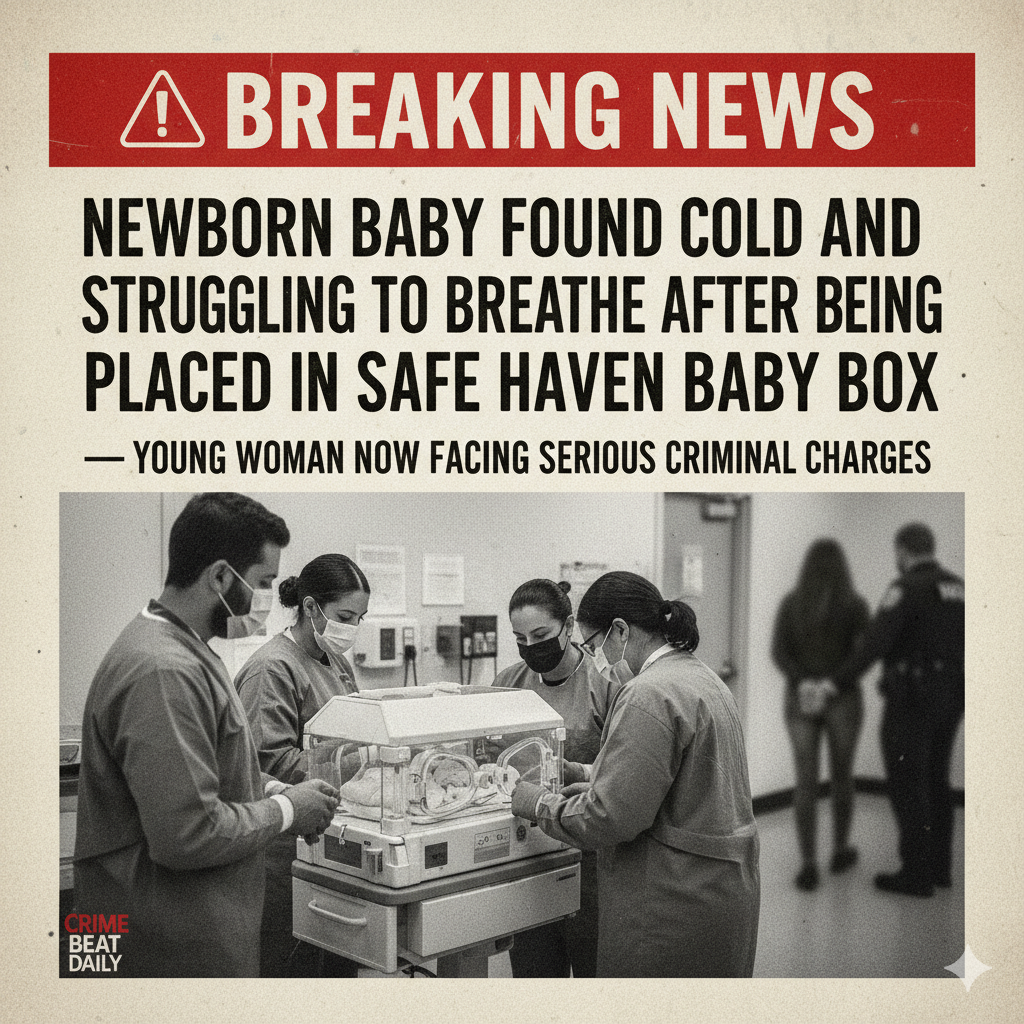In a case that has sent shockwaves through both the local community and across the nation, authorities in a quiet American town are investigating a deeply troubling incident involving a newborn baby discovered cold and barely breathing inside a Safe Haven Baby Box, a system designed to give desperate parents a legal and safe way to surrender their infants without fear of prosecution, yet in this instance, the circumstances surrounding the infant’s placement have raised alarming questions about negligence, responsibility, and the thin line between protection and abuse; according to police reports and eyewitness accounts, the infant girl, only hours old, was found in critical condition after being left in the box without the proper precautions, shivering and struggling for breath when emergency responders arrived, a scene that has been described by paramedics as both “heartbreaking” and “nearly fatal,” though thankfully the child was revived and rushed to the hospital where she remains under intensive care; while the Safe Haven law in most states allows mothers to surrender their babies safely and anonymously without facing charges, investigators allege that the young woman involved in this case did not follow the established process, instead placing the child in a condition that endangered her life, which has led prosecutors to file serious charges of child endangerment, neglect, and reckless conduct, sparking a heated public debate over where compassion for a struggling young mother ends and accountability for a life-threatening act begins; the girl at the center of the charges, whose identity is being withheld due to her age and privacy concerns, has already become a polarizing figure, with some community members condemning her as reckless and criminal while others argue she may have been scared, uninformed, and in desperate need of help, highlighting the gaps in public education about Safe Haven laws and the lack of resources available for vulnerable young women in crisis pregnancies; experts note that Safe Haven Baby Boxes are meant to be temperature-controlled, alarm-equipped, and designed for immediate intervention, yet in this case, something went terribly wrong, whether due to improper use or mechanical failure, leading many to ask hard questions about whether the system itself is foolproof or whether improvements are urgently needed to ensure no other newborn faces such a harrowing ordeal; law enforcement officials, however, remain focused on the actions of the mother, stressing that the baby’s survival was a miracle and that leaving a fragile infant in freezing conditions without notifying authorities or ensuring the box’s safety mechanism was triggered constitutes a criminal act regardless of intention, a stance that has ignited fiery debate across social media platforms, where hashtags such as #SafeHavenCrisis and #JusticeForTheBaby are trending as the story spreads rapidly; the hospital treating the newborn has issued a statement confirming that while she remains in critical condition, doctors are cautiously optimistic about her recovery, though they emphasize the risks of long-term complications given the period of oxygen deprivation and hypothermia she endured, an outcome that has only intensified the emotional weight of the case; meanwhile, advocates for Safe Haven programs warn that sensationalizing the incident could have unintended consequences, potentially discouraging other at-risk mothers from using the boxes for fear of legal consequences, while simultaneously urging lawmakers to strengthen awareness campaigns so that young women understand how and when to safely use these life-saving systems; the legal battle ahead promises to be complex and emotionally charged, with prosecutors signaling their intent to push for accountability while defense attorneys are expected to argue that the girl’s actions, though misguided, stemmed from ignorance, panic, and lack of support, not malice, raising broader societal questions about whether punitive measures or preventive solutions should be the priority in such cases; community leaders have already organized vigils and prayer circles for the infant, candles flickering in the night as residents express both sorrow for the baby’s suffering and compassion for a young mother whose life is now forever altered by a single desperate act, their gatherings reflecting the duality of outrage and empathy that defines public reaction; media outlets nationwide have seized on the story, drawing parallels to past cases where Safe Haven laws were either misused or misunderstood, while commentators debate the ethical dilemmas of criminalizing young mothers who may already be victims of poverty, abuse, or abandonment themselves; child welfare experts caution that the incident underscores systemic failings—insufficient access to prenatal education, lack of mental health support for teens and young women, and the stigma surrounding unplanned pregnancies—all factors that can drive vulnerable individuals into dangerous decisions that place innocent lives at risk; as investigators continue to piece together the timeline of events, from the girl’s pregnancy to the moment she placed her newborn in the box, the public waits with bated breath for clarity, torn between anger, pity, and the haunting image of a baby fighting for her first breaths alone in the cold; in the weeks ahead, court proceedings will likely expose painful details about the mother’s background, her state of mind, and the precise chain of events that led to this tragedy, but already it is clear that the case will leave a lasting mark, forcing lawmakers, communities, and families to reckon with the delicate balance between protecting infants and supporting vulnerable mothers, reminding us all that behind every headline is a fragile human life, a child who deserved warmth and safety from the very first breath, and a society that must decide whether to respond with punishment, compassion, or both.

